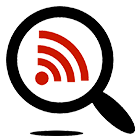Episodes
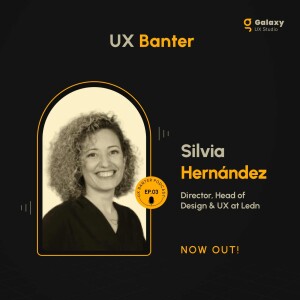
Wednesday Aug 07, 2024
UX Design Diaries: Over 16 Years of Global Insights - Silvia Hernández - S4 Ep. 2
Wednesday Aug 07, 2024
Wednesday Aug 07, 2024
In this episode, we are joined by Sylvia Hernandez, Director and Head of Design & UX at Ledn. Sylvia is a design enthusiast with over 16 years of expertise in crafting seamless digital experiences across various industries. From pioneering startups to public sector collaborations and diverse portfolio games, she plays a vital role in ideation sessions, operational tool development, and hands-on digital product creation. Discussion Points -
What inspired your journey in the design industry across multiple countries, and how did your professional path shape you into the expert you are today? 1:59
What differences do you notice working in finance for a startup versus an enterprise? Any distinct challenges or opportunities in each? 2:57
Rapid fire round 10:12
As a design leader, how do you balance diversity, inclusivity, and functionality in your team? 23:21
How do you shape the future of a startup when your passionate team is targeting a user base with a short attention span or limited understanding of the situation's gravity? What strategies ensure success in such a challenging scenario? 26:57
You host the Spanish-language podcast ‘Entre Diseñoras’ . What common themes do you see in your episodes, and how do they shape the show’s focus? 29:56
For young professionals starting their careers in various regions, what advice would you give them for building a brighter future in the industry? 34:11
Could you share more about your role as a mentor and the impact it has on your professional journey? 36:26Show notes -
When you begin your career as a designer, you initially focus on the craft of design. However, in certain corporations, it evolves into managing stakeholders and dealing with the aspects behind the design itself. It's truly fascinating to observe this shift.
In big companies, you have more resources, but in startups—where I am currently—I enjoy the ease of shipping things quickly. Unlike larger organizations, where processes and legacy systems can make innovation challenging, startups allow for rapid development and implementation.
In the crypto space, diversity is not widespread. When building my team to bring crypto to everyone, I emphasized the importance of diversity, especially with the underrepresentation of women in the sector. To appeal to a broader audience, it's crucial to have varied perspectives on the team.
I'm extremely cautious about team additions. I'd rather take my time hiring than rush and have to let someone go. It's crucial for me to bring in individuals who bring something unique to the team without disrupting our existing dynamic.
My friend Deanna and I, come together to interview guests from various fields, dedicating each episode to a year of experience in front of us. Our mission is to amplify the voices of those often overlooked, individuals doing remarkable work who may not always have the spotlight. In a podcast landscape dominated by familiar voices, we aim to introduce fresh perspectives and showcase the diversity of impactful contributions.
If you're a designer, there are two essential aspects to consider. Firstly, you have to care about people and understand their behaviors. Secondly, you cannot forget about the craft.
I believe it's a failure on our part as designers when we apply for roles by emphasizing our past achievements. Instead, the focus should be on showcasing our capabilities and what we can bring to the company. What do you see as the next step in this approach?
Links -Silvia’s LinkedIn: https://www.linkedin.com/in/silviahdezCompany’s website: https://www.ledn.ioSilvia’s Podcast: https://podcasters.spotify.com/pod/show/entredisenoras/
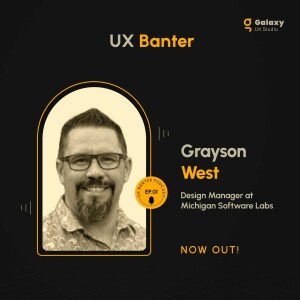
Wednesday Jul 24, 2024
Wednesday Jul 24, 2024
In today's episode, we are joined by Grayson West, Design Manager at Michigan Software Labs. He is forward-thinking leader in the realm of design, advocating for human-centric experiences. Demonstrating his leadership style, he seamlessly combines visual design and human-centered principles to create efficient systems.Discussion points:
Can you share your creative background and the key experiences that have shaped you into the design leader you are today? 1:27
Did you feel any pressure as a designer at The Omni Group to adopt tools like OmniGraffle when they were gaining traction in the design community, especially considering the presence of motion graphics in your work? 6:09
How have your life experiences, diverse travels, work across different domains, and the creative influences from your childhood impacted your approach to user experience design? 9:19
Rapid Fire Round 11:24
How do you navigate the challenges between adhering to UX principles driven by data while seeking creatively satisfying outputs in a field? 16:07
Does active engagement and cross-functional communication among UX, developers, and business analysts significantly impact product ownership and success from start to finish? 21:34
If you have to give young designers coming into the industry any advice what would that be? 27:50Show notes -
Before the iPhone, software was designed to be very capable for many users. However, with the iPhone's introduction, there was a shift toward a user experience focused on excelling in one or two key aspects within a software experience.
Traveling across Europe and Asia exposed me to diverse cultures, fostering an inherent empathy that influences my approach to solving user experience problems. It taught me the importance of simplicity, ease of use, and catering to diverse needs.
We need to take small incremental steps forward in our craft, whether it's in Figma, the way we approach design problems, or a wide variety of other aspects. Every day, we can strive to push ourselves forward, continuously improving and owning our craft.
The more designers acquire technical knowledge and language, the more likely they are to bring truly creative ideas to the world and users.
The one thing I've learned in nearly 20 years in this industry is that software development is a massive collaboration. It doesn't rely on one or two individuals but rather a team of people coming together to build a product. The more you collaborate, engage in open conversations, and show vulnerability within your team, the better the product will be.
Two pieces of advice: Get up to speed with technical documentation - focus on iOS and Android documentation, familiarize yourself with Apple's Human Interface Guidelines and Android's Material Design Guidelines, and expose yourself to popular web frameworks. Secondly, remember the visual aspect of our job - we need to consider and follow design principles.Links -LinkedIn: https://www.linkedin.com/in/graysongwest/ Company website: https://michiganlabs.com/
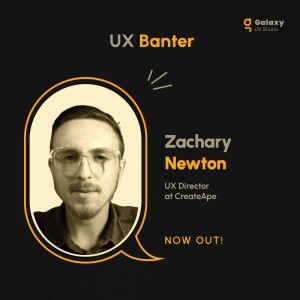
Thursday Sep 14, 2023
Unpacking the Dynamics of UX, AI, & Business with Zachary Newton - S3 Ep.14
Thursday Sep 14, 2023
Thursday Sep 14, 2023
In this episode, we're joined by Zachary Newton, the talented UX Director of CreateApe. With a background blending design leadership and tech prowess, he's a driving force behind creative endeavors in Brand, Product, UI/UX, Video, and Marketing. Zachary's passion lies in crafting experiences that harmonize business objectives and user satisfaction, going beyond pixels to shape digital innovation.
Discussion points -
What path did you follow to become the designer and creative professional you are today? 1:26
Do your past experiences significantly influence your current role and approach? 3:37
Do you believe that achieving a high level of discipline is crucial when self-learning to establish a career compared to pursuing formal education? 6:36
Rapid fire round 7:49
How do no-code and low-code platforms impact the user experience when compared to custom-built solutions, and what are your thoughts on their significance in UX design?11:13
How do you and your team stay up-to-date with evolving technologies and trends to ensure you remain competitive in delivering products and services? 16:43
Tell us about the podcasts you host. 23:48
What advice would you give to individuals who are just starting their careers and aspire to reach the level of expertise you have achieved? 27:05
Show notes -
I started with development and later shifted to design to work on products I found enjoyable. It allowed me to influence their appearance, functionality, and perception, primarily focusing on design, with some development involvement.
I often advise people, even during user or stakeholder interviews, to ask 'why' multiple times. You might have heard of this technique, but it's essential to approach a question from various angles to uncover the true answer.
Everything I've done up to today, including video editing, design, and development, has been self-taught. I haven't received a traditional education in these fields.
You've always got to have that hunger and drive to educate yourself, to understand what you don't know and learn from it.
I'm personally a fan of low-code and no-code solutions. I believe they are excellent for rapid development, iteration, and testing. However, there may come a point where a custom solution is necessary. Two of my favorite low-code and no-code platforms are Webflow and FlutterFlow, which allow you to build websites and applications.
I believe that as creatives or agencies, we need to embrace AI tools rather than fear them and figure out how to incorporate them. In the future, it will be about orchestrating the synergy between these tools and technologies.
In the Soapbox Business Show podcast, my co-host Mario and I interview various business professionals, mainly those who own or run their businesses. We firmly believe that regardless of their industry, these conversations offer valuable insights and information.
There have been instances where I've found that what is taught in classrooms is outdated or no longer relevant. To stay ahead, it's essential to stay hungry, continue learning independently, and be hands-on. These factors combined will contribute to your success.
Links - LinkedIn: https://www.linkedin.com/in/zacharyrnewton/ Company website: https://www.createape.com/Portfolio/ website: https://zacharynewton.me/Podcasts: https://podcasters.spotify.com/pod/show/story-archiveshttps://soapbox.house/
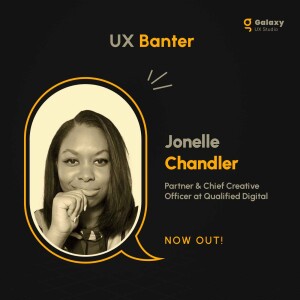
Thursday Sep 07, 2023
Amplifying Diversity in Design: A Discussion with Jonelle Chandler - S3 Ep.13
Thursday Sep 07, 2023
Thursday Sep 07, 2023
In this episode, we are joined by Jonelle Chandler - Partner and Chief Creative Officer at Qualified Digital. A dynamic design leader dedicated to empowering diverse design thinkers and bridging the gender and ethnic gap in tech. She actively mentors through programs like Built By Girls, ADPList, Women in Wireless, Blacks Who Design, and the Invision Design Leadership Forum, excelling in crafting innovative digital experiences by harmonizing business objectives, technology, data, and creativity.
Discussion points -
What influenced your career choice, and how did you become the professional you are today? 1:50
Can you outline the connections and distinctions between your shift from architecture to UX design, along with the transferable insights between these domains? 2:51
What key distinction do you see between designing for Enterprise UX and designing for the typical user experience of consumer products? 6:15
Please share your insights regarding the return on investment (ROI) of Enterprise UX. 8:23
Rapid fire round 9:30
How do you ensure diversity and inclusion within your design team to promote diverse design thinkers and innovative digital experiences? 16:32
Could you share your experience with ADPList and the mentoring you've provided in general? What common themes do you often address in these contexts? 28:54
For internal mentorship and nurturing talent towards management roles, how do you ensure continuous growth and opportunities within your team? 31:24
How can interested individuals best reach out to you or your company regarding the positions you're currently hiring for? 35:15
Show notes -
Employed at an architecture firm, I discovered it wasn't my passion, gaining insights into the business. I found myself drawn to graphic design, and that's what initiated my career journey.
What's truly advantageous in UX is its digital nature; you can create a wireframe or design concept, observing and editing it in real time—an experience not easily replicated in architecture.
When designing for B2C or consumer contexts, it's about 95-100% focused on the user. In contrast, with enterprise design, you're navigating a balance and juggling various requirements while striving to create a robust product.
Many of our clients primarily measure their return on investment through product sales and the leads they generate, including lead qualification. Additionally, we're observing a shift towards more people-centric communication and experiences in our approach. At times, it's challenging to directly quantify these aspects with a traditional return on investment framework.
What I've found to be effective is having a project manager and representatives from different areas like tech, design, UX, and data analytics. We involve everyone right from the start, and although the project manager leads, each of us voices our team's perspective on what we believe should be done.
You need to regroup; having a single person dictating won't work. Firstly, nobody would want to collaborate with that team or individual. Secondly, the outcome would be a product tailored solely for that person, lacking input from others.
I think mentorship plays a vital role; I've gained valuable insights from my team, and we've learned collectively. It contributes to our professional growth, work-life balance, and personal development beyond the workplace.
Links-
LinkedIn: https://www.linkedin.com/in/jonellechandler
Company website: https://qualifiedigital.com/
Personal website: https://www.jonellechandler.com/
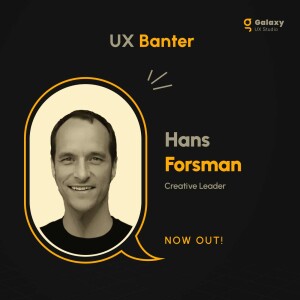
Thursday Aug 31, 2023
Thursday Aug 31, 2023
In this episode, we are joined by Hans Forsman, an award-winning Creative Director known for his "can do" attitude and strategic brand expertise. With a remarkable track record, he's transformed goals into unforgettable results, crafting brand stories and cutting-edge campaigns. From Reebok to HBO Now, Hans has left his creative mark across diverse industries.
Discussion points -
How is the creative industry in LA, the epicenter of international creativity with Hollywood and major game studios, faring amid co-branding, collaborations, and bustling activity? 2:06
When discussing your experience in LA, could you share your journey? Did you start your career there, and how did you transition into becoming the creative professional you are today? 3:38
In the realm of UX and CX, including customer experience, how crucial is effective storytelling? 15:57
Rapid fire round 22:15
Could you talk about your experiences with AR during the early days of the technology? 35:03
What is the future trajectory of AI and machine learning in the context of Human-Computer Interaction (HCI), also known as ACD, and how do you envision its impact on our current direction? 44:46
On the education side, can you talk to us about the courses you teach? 50:58
What advice would you offer to aspiring designers looking to follow your path? What key do's and don'ts would you suggest? 55:54
Show notes -
I look at my past and how I've reached my current position. It has always been about seizing the moment, recognizing opportunities, and confidently stepping forward without fear.
As a creative director, I enjoy involving my teams in that story, fostering their passion and excitement for the product.
If you fast forward now, in terms of the use of AI, consider how that experience can evolve to create a much more immersive interaction. It brings order to the chaos and helps people delve deeper into interactive experiences.
The best and the easiest way that has always worked with storytelling is to get into the mindset and put yourself in the shoes of the people who would be in the story.
We executed some projects, such as the Barbie Dream Closet where people could see themselves wearing Barbie clothes. One significant project was during New York Fashion Week, where we utilized our product, the webcam social shopper.
The more time I spent on various studies and working on UI/UX to understand how people interact with it, I quickly realized that I don't believe it will fully evolve until mixed reality becomes feasible. Mixed reality is where there are no inhibitions, like wearing glasses that seamlessly blend our realities.
I use AI daily as an integral part of my work routine. It provides advice, writing tips, ideation, and data analysis support, enabling me to enhance my productivity and creativity. What's truly wonderful is that it demands our input, making it a collaborative tool for unleashing innovation.
Understanding UI/UX as a crucial part of our future interactions, and how we engage with it, will impact society and shape our world. As everything evolves, from user experience to customer experience, comprehensive understanding implies greater societal progress.
Links -
LinkedIn: https://www.linkedin.com/in/hansforsman/
Portfolio/ website: https://hansforsman.com/
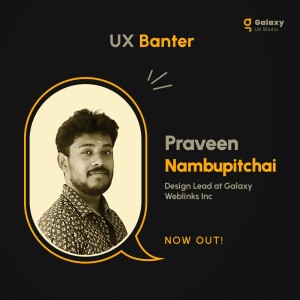
Thursday Aug 24, 2023
Thursday Aug 24, 2023
In this episode, we are joined by Mr. Praveen Nambupitchai, the Design Lead at Galaxy Weblinks Inc. A self-taught design expert with 6.5 years of experience, Praveen specializes in UI and product design. His profound knowledge of UI design has honed his ability to craft intuitive and visually striking interfaces that deliver an enhanced user experience. Beyond his expertise, Praveen mentors aspiring designers, guiding them in skill development and career advancement.
Discussion points -
Could you share the journey that led you to become a design extraordinaire and educator? 2:08
Did the self-taught learning journey, including discipline and reliance on online resources, ever lead to self-doubt or uncertainty about your ability to succeed as a designer? 4:11
Apart from talent, what key factors do you consider pivotal in shaping you into the accomplished designer you are today? 5:18
When facing intermediaries like managers or client representatives who filter design feedback, how do these challenges influence your design attitude and motivation? 6:59
Transitioning from solo work to collaborating with teams on multiple projects, what key differences have you observed in your design approach and overall experience? 9:48
Rapid fire round 11:19
Shifting from a designer to mentor and course creator, how challenging was it to adapt your focus, develop a curriculum, and bridge design approach gaps? 20:03
With Figma introducing new features like variables, multilingual support, data sets, and AI capabilities, what's your perspective on these changes? 22:59
Regarding generative AI tools in the creative industry, do you see them as a threat or a benefit? Will they reshape your design approach, or have a more positive impact? 25:47
Could the integration of advanced features like generative AI in tools like Figma result in a steeper learning curve for designers and the need for specialized professionals in prototyping and interactivity? 29:04
What advice would you give to aspiring designers who admire portfolios like yours and dream of becoming accomplished designers themselves? 30:31
Show notes -
I didn't attend any school to learn design, and during that time, there weren't any online platforms available for learning either. The only source I had was YouTube. I absorbed all the videos that people had recorded and posted. This was also a period when the design was undergoing significant evolution.
I don't closely follow design trends, as they change constantly. Instead, I focus on maintaining consistency through practice and frequent iterations. I don't settle with just one design; I keep iterating until I'm truly satisfied.
I gather various inputs to determine what will work well visually and experientially. While some might believe visuals alone suffice for a product, the experience also plays a significant role.
When working alone, your decisions rely solely on your own judgment and experience. However, collaborating with a team introduces new perspectives and surprising possibilities that you might not have considered on your own.
Teaching is something I aspire to do beyond this industry, given my personal journey through challenges. Recently, I've observed individuals enthusiastically taking online courses in various fields, including UX. However, there remains a significant gap in teaching the art of crafting quality designs. This gap is what I aim to address through my mentorship.
Figma's recent foray into AI is quite intriguing, particularly the demo they showcased. There have been concerns that AI might take over jobs, but as seen in the demo, these tools aren't actually performing design tasks.
As a designer, you are understanding how engineering functions is essential, as your role extends beyond creating a design. Designing is just the beginning; you're involved in the entire process, from building the design to development, leading to a sense of satisfaction once the product is complete.
When starting your career, gather references from established professionals, especially those focused on consistent enterprise and real product design, rather than chasing trends that are ever-changing.
Links -LinkedIn: https://www.linkedin.com/in/praveen-n-964560151/
Company website: https://www.galaxyweblinks.com/
Portfolio/ website: https://www.behance.net/pravinrj27
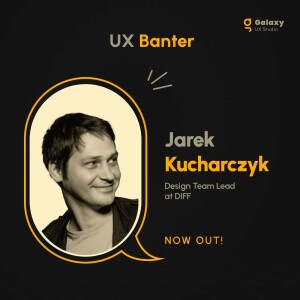
Thursday Aug 17, 2023
Exploring the Intersection of Art and UX Design - Jarek Kucharczyk - S3 Ep. 10
Thursday Aug 17, 2023
Thursday Aug 17, 2023
In this episode, we are joined by Jarek Kucharczyk, the Design Lead at DIFF—a true polymath, spanning art, education, and innovation. From teaching design to rocking out with his metal band and crafting captivating oil paintings, his creativity knows no limits. With over 22 years of experience, he effortlessly melds user-centered design and Shopify brands for exceptional experiences. His commitment to innovation has led to partnerships with Nestle, Samsung, and Discovery Channel.
Discussion points -
With your various roles and being a family man, how do you manage such a diverse set of responsibilities effectively? 1:52
How did you begin your career and how did you arrive at your current position? 3:14
How has your experience of bridging the cultural context between Europe and North America influenced your approach to user experience design and product development? 6:23
What's the connection between art and UX design, given your background transition, and how does problem-solving and design thinking fit into this relationship? 9:16
Rapid fire round 12:07
Why do you believe networking is crucial for designers, and why is it important to ensure that conversations within your network remain relevant and valuable? 18:08
Do you think remote work for designers is less productive than office work, and how does it impact creativity, considering your company's remote setup? 19:46
Could you provide more details about the online courses you teach and the subjects you cover in your courses? 24:03
What advice would you give to those entering the design field about navigating their career journey over the next decade or so? 26:58
Show notes -
Balancing life and work is often easier said than done and it greatly depends on your personal circumstances. For instance, having small children can make it more challenging.
As far as I remember, I knew I wanted to be an artist. I recall as a child, I would look at other people's works and try to replicate them. I always knew I was going to be an artist.
When I came to Canada, it was the biggest surprise for me. I was expecting advanced technologies, and while they do exist here, their implementation is not as intense as it is in Europe.
I would always advise every designer to go big with your ideas. There is no such thing as a bad idea, especially in the ideation phase. Every idea, even if initially considered not suitable, could lead to another idea that inspires better solutions.
Collaborating with other people is in my blood; it's something I feel is the most effective way to achieve incredible things by drawing inspiration from one another and creating something together.
A lot in terms of creativity depends on how ideas are bounced off each other. The facilitator of the conversation plays a crucial role, whether it's in a digital environment or a physical meeting room. They set the foundation for productive and creative discussions.
I teach three courses. One is called "Visualizations," which covers the fundamentals of visual design. The other one is "Information Design," focusing on data collection, interpretation, visualization, and drawing conclusions from it. The third one is "Physical Interfaces," which is particularly intriguing as it involves blending the digital and physical worlds.
When I observe my students and the industry, people often kill ideas too quickly before exploring their potential variations. Being brave is crucial; it's the key to success. Be bold with your ideas, think of the impossible, and then consider how to make it a reality.
Links -
LinkedIn: https://www.linkedin.com/in/jarekkucharczyk/
Instagram: https://www.instagram.com/jarek_designer/
Company website: https://www.diffagency.com/
Portfolio/ website: http://www.jarekdesigner.com/
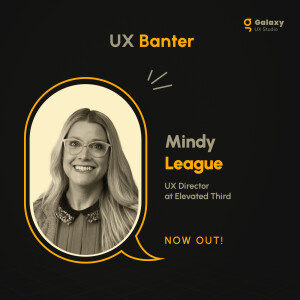
Thursday Aug 10, 2023
Thursday Aug 10, 2023
In this episode, we are joined by Mindy League, the UX Director at Elevated Third. A true master of design thinking, research, and UX expertise, she has the remarkable ability to align business objectives with user needs, making her a valuable asset to enterprise stakeholders. With a unique blend of empathy, design thinking, and research expertise, she crafts exceptional product experiences for top global brands like HP, Emerson, and IBM.
Discussion Points -
Can you share your journey and what led you to choose a career in UX design, ultimately reaching the position of UX Director at Elevated Third? 1:35
How was the transition from living in Texas to moving to New York and working as a product designer there? 5:23
Do you believe that experiencing the humane side of New York city contributed to your empathic approach to user experience design? 7:03
What were the similarities and major differences you experienced during your transition from physical product design to software product design, and how do you find both roles? 10:36
Do you believe having a variety of experiences in their career is crucial for designers aiming to become design leaders and make a bigger impact? 16:13
Rapid fire round 18:12
How does UX connect with marketing, considering that marketing revolves around business goals and financial outcomes? 26:53
What are some leadership challenges that you think you learned the hard way? 32:18
What is the advice you would give to green designers? 33:35
Show notes -
It was interaction design when I started; UX hadn't been defined. The people at IBM had backgrounds in human factors and engineering human interactions. I had been doing it for a long time. And so as we were stepping out, we were saying, "We do UX, user experience design."
Vulnerability is something that people are sometimes shy to show, but once you do, you can really connect with other people, including your clients and users, and bring that through the whole process.
Comparing physical and digital product design reveals similarities and differences. Physical products offer tangible satisfaction and visibility, while digital products provide flexibility for adjustments like fixing typos. However, rectifying errors in shipped physical products can be more complex.
Design thinking really helps when you have a brief. It's abstract, and you don't know exactly what they have in mind. With design thinking, you can tease out more information, explore it, and dissect it like a prism.
Continually learning, evolving, and being open to keeping up with technology while relying on mentors to help with transitions are extremely important, even if the mentor is not in your field, as they have the background to guide you and apply proven learnings to your work, ushering you into those transitions.
The type of work we do at Elevated Third involves working with B2B SaaS companies, where our focus is on creating websites that generate customers for them, rather than directly working on the SaaS product itself.
A lot of the companies we work with are collaborating with branding agencies. These agencies bring us new brand elements for which we design new websites, reflecting the invigorated and youthful nature of the brand. However, their old products don't resemble this new brand in any way.
We are really focused on website marketing, particularly for selling products, occasionally dipping into product design. However, we prioritize hiring designers with marketing backgrounds and individuals who are open to business objectives.
I have continued to use mentors today, even though I might be the director of the organization, for accountability purposes. Luckily, my organization sees the value of mentors and brings in consultants and people for us to work with, even though we are on the leadership team.
Links -
LinkedIn: https://www.linkedin.com/in/mindyleague/
Company website: https://www.elevatedthird.com/
Portfolio/ website: https://www.behance.net/mindyleague
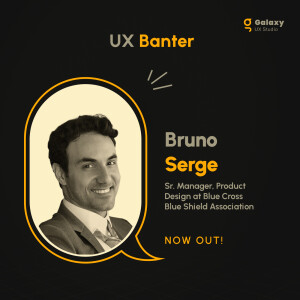
Thursday Jul 27, 2023
Decoding the Art of Design and the Science of Influence with Bruno Serge - S3 Ep.8
Thursday Jul 27, 2023
Thursday Jul 27, 2023
Join us in this episode with Bruno Serge, Sr. Manager of Product Design at Blue Cross Blue Shield Association. With over two decades of cross-disciplinary design, writing, and technology leadership experience, Bruno is a true creative mastermind. From renowned brands like Guitar Hero, Blizzard, and Bungie to contributing to Call of Duty: Black Ops 4's success, he solves complex human problems with boundless creativity, leaving a lasting impact on the design industry.
Discussion points -
What inspired you to choose a career in design, and how do you see the intersection of engineering and design in your professional journey? 1:26
Engineering & Design - How do these two worlds meet in your opinion? 4:52
How did your background in different cultures and countries impact you as a professional? 8:35
Rapid fire round 18:43
What are your thoughts on the widespread adoption of the new vision pro and its potential impact on culture and society? How will designers and individuals cope with its addictive nature and the influence of the reward economy? 31:19
With the convergence of various technologies like AI techniques, voice interfaces, and advancements in AI, what role do you think it will play in the field of 3D design? 34:11
What advice would you give to young professionals who are just starting out in this field? What actions should they take, and what should they avoid? What's the mantra for success in their career? 39:04
Show notes -
Throughout my life, I've always been eager to build things. And it was kind of a divide between an artistic form of building things and engineering problem-solving.
As a generalist, I was never able to really focus on one thing, I always wanted to learn more and more in terms of what I like, to broaden my horizons, and learn multiple skills in order to adapt and combine them.
We were applying research and best practices to make the games more addictive , which was a great problem-solving approach from a business perspective. It allowed us to sell more games, and indeed, we achieved that. However, I also had moments of reflection where I questioned the social and cultural implications that might arise from this. It led me to reconsider the ethics of what I was doing.
There's nothing that a human being can create, be it problem-solving, or a machine, anything that doesn't have a little touch of artistry to it.
When you build a website, it's not exactly like painting, you have to consider the limitations of technology, you have to consider how users will perceive it, and how they will interact with it. So there's a lot of best practices, a lot of rules that go into that.
Throughout my career, I've encountered this situation numerous times: while trying to solve a human problem, I get interrupted by a business problem that I haven't quite cracked. These two issues are not exactly the same thing.
There is inertia toward having more visual interfaces, and I believe the Vision Pro is a symptom of that. It will undoubtedly steer things further in that direction in the coming years.
I believe a technology like (AI/VR) will always have a little bit of an osmosis effect, influencing the development of anything related to 3D, due to the heightened awareness that customers will have.
Designers should be more selfish, particularly when considering their portfolios. The nature of a designer is iterative, focusing on solving problems and creating better experiences for humans, which is great. However, in our current system, designers also need to consider how their work will look in their portfolio in the long term.
A while back, I switched from Dribbble to Behance. And I'm much happier in the way that I can showcase my portfolio.
Links -LinkedIn: https://www.linkedin.com/in/theartist/ Twitter:https://twitter.com/sergesfeed Instagram: https://www.instagram.com/brunosthings/ Company’s website:https://brunoserge.com/ Portfolio/website: https://www.behance.net/brunoserge
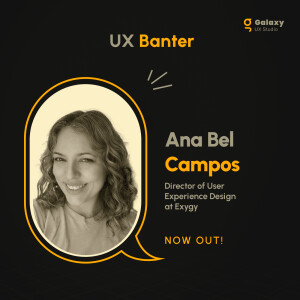
Thursday Jul 20, 2023
Designing with Empathy: The Psychology Behind UX - Ana Bel Campos - S3 - Ep. 7
Thursday Jul 20, 2023
Thursday Jul 20, 2023
Our guest today is Ana Bel Campos, the Director of User Experience Design at Exygy. With 17 years of experience, Ana is a powerhouse in design and product management. She embraces fundamentals, explores new ideas, and puts the user at the heart of the design process. Known for her expertise in storytelling, product strategy, and growth, Ana combines creative freedom with a strong product management background to create impactful user experiences.
Discussion point -
How has the journey been so far? What are the things that you have experienced and how has the path been for you? 1:23
How did you get into this field? 4:09
What is the difference between human behavior economics and human behavior psychology? 5:35
Rapid fire round 12:07
What is the difference while you're designing for social impact versus when you're designing for profit? 19:40
Can you elaborate on the terms - equity-centered design and community-centered design? 24:34
At Exergy, what kinds of projects are generally undertaken? What is the clientele? 28:16
What would be your advice to young professionals starting their careers in design? 30:28
Show notes -
I always like to say that even as a product manager, I was actually a UX designer. Because even as a product manager, my main focus was always making sure that we are crafting experiences that are intuitive, simple, accessible, and delightful.
I was always passionate about understanding humans and how they think and why they make the decisions that they do.
I think empathy is a really big thing in UX and human-centered design. And I think it's one of our core values.
Designer needs to have this ability to sometimes forget about themselves, and what the solution is, just listen to the user's needs and let the solution come naturally.
When you're designing for social impact, the designer is far removed from the lived experience of the user.
When you're designing for social impact, you need to go above and beyond. You need to actually close that gap between the designer and the user, which means really bringing the user to the design process.
I think that idea of inclusivity, and equity is way more important when you're talking about designing for social impact.
I see a disconnect between the tech world and the social impact world. And, what we're trying to do at Exergy is bridge those two worlds.
I don't think that AI will be able to understand humans in the way we understand humans.
If I could give people advice, focus on the human aspects of user experience.
Links -
LinkedIn: https://www.linkedin.com/in/anabelcampos/
Company website: https://www.exygy.com/
Medium: https://medium.com/@anabelcampos

A fun and conversational podcast where the design industry experts share their story, learnings, and the processes they follow to create successful digital products and user experiences.







